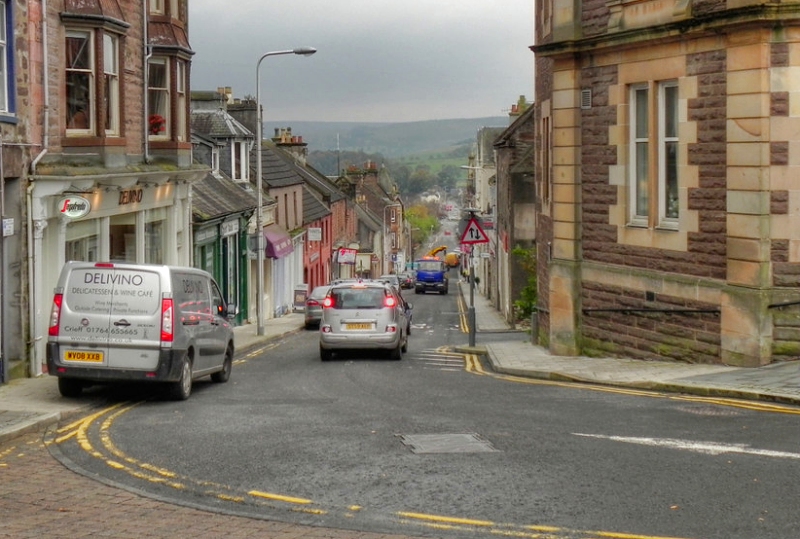
We turn sharply west, then north, on all colors of roads, heading toward Fowlis Wester, a small village in Perthshire which is notable for its 13th century church and Pictish cross-slabs. It is not the church which is on our "must see" list though; rather, it's the collection of standing stones and cairns on a moor north of the village. This is a breathtaking drive that sets my imagination afire. It's as if all of lowland Scotland is spread out before me like a green velvet patchwork quilt.
I gaze out the windows dreaming of raising my children in this land, picture them romping and rolling down the hills, seeking out insects and small furry creatures, imagine an herb garden outside my kitchen door and moss covered paving stones, log fires hissing on long cold winter nights and streaks of bright sunlight angling down through the clouds on days such as today. Traffic seems to be picking up a bit; I shake myself from my reverie and take a peek at the map.
As it turns out, we have to drive through Crieff, a sizable town just west of Fowlis Wester and decide to make a quick stop in search of an optician – a quick stop that turns into several hours of rambling around this busy market town.
Known as Drummond in the 17th century, after its local patrons, the Drummonds of Perth, its original name, Crieff (Crubha Cnoc, Gaelic for Hill of Trees), was restored following destruction in 1716 by retreating Jacobites. The town spills down a steep hillside above the River Earn, with the town center obviously artificially leveled. Parking at the bottom of this steep hillside, we then hike, almost vertically, up to High Street.
We duck into the Tourist Information Centre to inquire about an optician but find that our timing is terribly off. We've hit Crieff just at lunchtime, so both opticians' offices are closed. On the other hand, maybe the timing isn't so bad after all. We decide to have a bit of lunch ourselves and, following the recommendation of the kind lasses at the information center and their map, are soon seated at Logos Tea Shoppe.
A fortifying cheese toastie and Pepsi with plenty of ice is welcome and needed, for soon we've set off for James Square off High Street for some window shopping and hopefully a chemist that sells a do-it-yourself eyeglass repair kit.
Crieff is bustling on this sunny Saturday and we fit right in with the crowd, meandering along, peering into windows and stopping on street corners to take in a wider view. I study the map that the lasses provided us with and am surprised at how much there is to see and do in the immediate area: Glenturret Distillery, Drummond Castle, several nature walks and parks and a visitor center with a garden center and pottery shop. Fowlis Wester and beyond calls though, so we head back down the hill in the general direction of the car park.
It doesn't take us long to realize that we've become a bit turned around as, suddenly, we're in a residential area. The narrow twisting streets are a maze of multilevel rowhouses that seem to rise to dizzying heights. There's no one to be seen – they must all be in town shopping. I recognize (or think I recognize) a sign at the very bottom of the hill and we head down, down, down only to discover there's no car park here, nor any sign of a car park. Back up the hill we hike to High Street again, walk several more blocks and, recognizing a decorators' center, finally find the right street.
Crieff is a small town, with a population of less than 10,000. Who would have thought it would be so easy to get lost on foot here, especially with a map in hand? Leave it to me to find a way.

Crieff is a Scottish market town in Perth and Kinross. It lies on the A85 road between Perth and Crianlarich, and the A822 between Greenloaning and Aberfeldy. The A822 joins the A823, which leads to Dunfermline. Crieff has become a hub for tourism, famous for its whisky and history of cattle droving.
For a number of centuries Highlanders came south to Crieff to sell their black cattle, whose meat and hides were avidly sought by the growing urban populations in Lowland Scotland and the north of England. The town acted as a gathering point for the Michaelmas cattle sale held each year, when the surrounding fields and hillsides would be black with the tens of thousands of cattle.
During the October Tryst (as the cattle gathering was known), Crieff was a prototype "wild west" town. Milling with the cattle were horse thieves, bandits and drunken drovers. The inevitable killings were punished on the Kind Gallows, for which Crieff became known throughout Europe.
Read more about Crieff at Wikipedia.